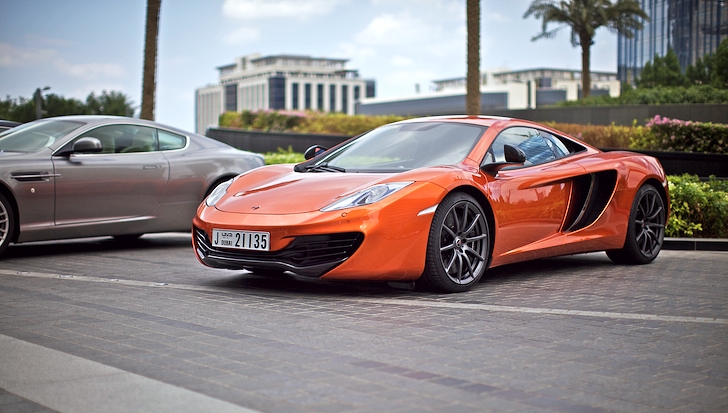For footage that barely lasts a minute, you can see the launch control, the air-brake spoiler, the active suspension, the braking power and even the exhaust note, all shot during our road-test just outside Dubai.
General Facts about McLaren MP4-12C:
Design
In 2008, McLaren hired Frank Stephenson as design director for their reborn production car project.
As with the McLaren F1, carbon fibre is used extensively in the vehicle to minimise weight. The MP4-12C weighs 1,301 kg (2,868 lb) dry.
The chassis is based around a F1 style one-piece carbon fibre tub, called the Carbon MonoCell, weighing only 80 kg (176 lb). The MonoCell is made in a single pressing by using a set of patented processes, using Bi-Axial and Tri-Axial carbon fibre multiaxial fabrics produced by Formax UK Ltd. with the MonoCell manufactured by Carbo Tech in Salzburg, Austria. This has reduced the time required to produce a MonoCell from 3,000 hours for the F1 and 500 hours for the Mercedes-Benz SLR McLaren, to 4 hours for the MP4-12C.
The car has a conventional two side-by-side seating arrangement, unlike its predecessor the McLaren F1 which featured an irregular three seat formation (front centre, two behind either side). To make up for this however, the car’s central console is narrower than in other cars, seating the driver closer to the centre. Interior trim and materials can be specified in asymmetric configuration – known as “Driver Zone”.
Engine
The car is powered by the M838T 3.8 litre twin-turbo V8 engine, designed and developed by McLaren in partnership with Ricardo. The design of the engine was based on a racing engine which was designed and developed by Tom Walkinshaw Racing for the IRL Indy Car Championship but never raced. However, other than the 93 mm bore, little of that engine remains in the M838T. It produces 592 bhp (441 kW; 600 PS) and 443 lb·ft (601 N·m) of torque. It has a redline of 8,500 rpm, with 80% of torque available at just 2,000 rpm. When first announced, McLaren claimed that it would have a higher horsepower to carbon dioxide emission ratio than any internal-combustion engine available at the time.
McLaren announced a small number of improvements to become available in October 2012, with the option to be retrofitted to existing cars free of charge. The engine now produces 616 bhp (459 kW; 625 PS) and no change to the CO2 emissions which remain at 279 g/km. This power output has also become standard on the 2013 model.
To watch the video, check the following link out:
http://www.youtube.com/watch?feature=player_embedded&v=8Bz1038NXlc
For more information about car price Estimate, please visit



